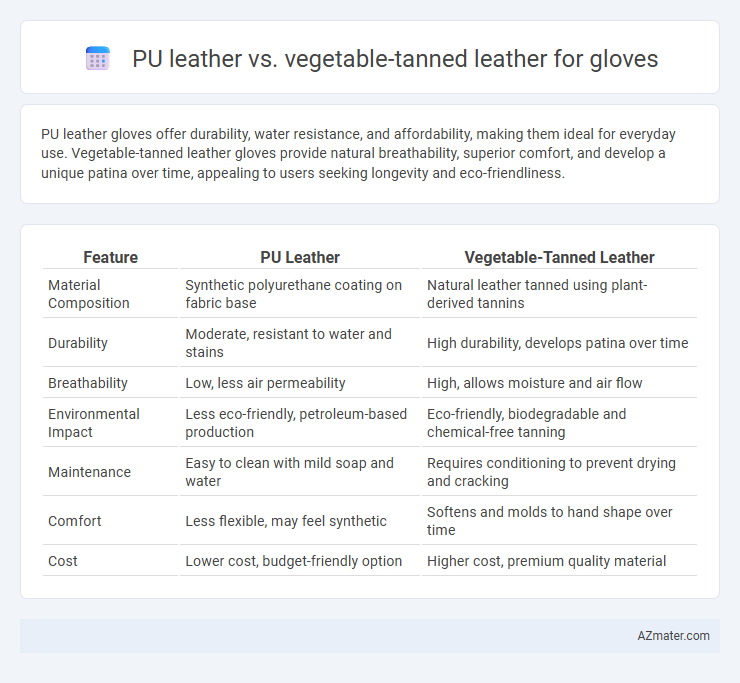PU leather gloves offer durability, water resistance, and affordability, making them ideal for everyday use. Vegetable-tanned leather gloves provide natural breathability, superior comfort, and develop a unique patina over time, appealing to users seeking longevity and eco-friendliness.
Table of Comparison
| Feature | PU Leather | Vegetable-Tanned Leather |
|---|---|---|
| Material Composition | Synthetic polyurethane coating on fabric base | Natural leather tanned using plant-derived tannins |
| Durability | Moderate, resistant to water and stains | High durability, develops patina over time |
| Breathability | Low, less air permeability | High, allows moisture and air flow |
| Environmental Impact | Less eco-friendly, petroleum-based production | Eco-friendly, biodegradable and chemical-free tanning |
| Maintenance | Easy to clean with mild soap and water | Requires conditioning to prevent drying and cracking |
| Comfort | Less flexible, may feel synthetic | Softens and molds to hand shape over time |
| Cost | Lower cost, budget-friendly option | Higher cost, premium quality material |
Introduction: Understanding PU Leather and Vegetable-Tanned Leather
PU leather, a synthetic material made from polyurethane coating over a fabric base, offers durability and water resistance ideal for gloves used in various activities. Vegetable-tanned leather undergoes an eco-friendly tanning process using natural tannins from tree bark, imparting breathability, flexibility, and a unique patina over time. Understanding the distinct properties of PU leather and vegetable-tanned leather is crucial for selecting gloves that balance comfort, longevity, and environmental impact.
Overview of PU Leather: Composition and Features
PU leather, also known as polyurethane leather, is a synthetic material made by applying a polyurethane coating to a fabric base, typically polyester, creating a durable and flexible surface. It is water-resistant, easy to clean, and offers a consistent texture and color, making it a popular choice for glove manufacturing. Unlike vegetable-tanned leather, PU leather lacks natural breathability but provides an animal-friendly, cost-effective alternative with excellent resistance to wear and tear.
What Is Vegetable-Tanned Leather? Key Characteristics
Vegetable-tanned leather is crafted using natural tannins from tree bark, leaves, and other plant sources, resulting in a material that is eco-friendly and durable. It develops a rich patina over time, enhancing its appearance and softness with age, unlike PU leather which is synthetic and prone to cracking. Key characteristics include breathability, firmness, and the ability to mold comfortably to the hand, making it ideal for high-quality gloves that require longevity and natural feel.
Durability Comparison: PU Leather vs Vegetable-Tanned Leather
PU leather offers high durability with excellent resistance to water, stains, and abrasion, making it ideal for gloves used in wet or harsh conditions. Vegetable-tanned leather, while more susceptible to moisture and wear, develops a unique patina over time, enhancing both strength and aesthetic appeal with proper care. For gloves requiring maximum longevity and easy maintenance, PU leather outperforms vegetable-tanned leather in durability.
Comfort and Flexibility in Gloves: Material Differences
PU leather offers superior flexibility and softness, making gloves more comfortable for extended wear and allowing better hand movement. Vegetable-tanned leather, although durable and sturdy, tends to be stiffer initially but softens over time with use, providing a firmer fit and natural breathability. The choice between PU leather and vegetable-tanned leather gloves impacts comfort levels, where PU leather suits lightweight, flexible applications while vegetable-tanned leather excels in durability and gradual molding to the hand.
Environmental Impact: Eco-Friendliness of Both Leathers
PU leather, made from synthetic polymers, has a lower immediate environmental footprint compared to vegetable-tanned leather as it requires less water and no animal resources, but its production involves non-biodegradable plastics contributing to long-term pollution. Vegetable-tanned leather uses natural tannins from plant sources, making it biodegradable and less chemically intensive than chrome-tanned alternatives, but the livestock farming for raw hides contributes significantly to greenhouse gas emissions and land use. Both materials present environmental trade-offs, with PU leather favoring reduced animal impact and vegetable-tanned leather providing greater biodegradability and renewable tanning resources.
Cost Analysis: Affordability vs Longevity
PU leather gloves offer an affordable option with lower upfront costs, making them appealing for budget-conscious consumers, while vegetable-tanned leather gloves incur higher initial expenses due to their natural tanning process. Despite the higher price, vegetable-tanned leather provides superior durability and ages gracefully, resulting in longer-lasting gloves that can reduce replacement frequency and total ownership cost. The cost analysis reveals that PU leather prioritizes short-term savings, whereas vegetable-tanned leather emphasizes long-term value through longevity and resilience.
Aesthetic Appeal: Visuals and Aging Over Time
PU leather gloves offer a consistent, smooth surface with vibrant colors that maintain their original look without significant changes over time. Vegetable-tanned leather gloves develop a rich patina, darkening and exhibiting unique creases and texture variations that enhance their character with age. The natural aging process of vegetable-tanned leather creates a distinctive, vintage aesthetic, while PU leather remains uniform and synthetic in appearance.
Best Use Cases for Each Material in Glove Production
PU leather gloves offer excellent water resistance and durability, making them ideal for work gloves and outdoor activities. Vegetable-tanned leather gloves provide superior breathability and natural flexibility, preferred for high-quality dress gloves and traditional craftsmanship applications. Each material caters to specific user needs, with PU leather excelling in rugged environments and vegetable-tanned leather favored for comfort and aesthetic appeal.
Conclusion: Choosing the Right Leather for Your Gloves
PU leather offers water resistance, affordability, and easier maintenance, making it suitable for gloves used in wet or budget-conscious environments. Vegetable-tanned leather provides durability, breathability, and develops a unique patina over time, ideal for gloves requiring natural aging and superior comfort. Selecting the right leather hinges on your priorities: choose PU leather for cost-effective, low-maintenance gloves and vegetable-tanned leather for high-quality, long-lasting, and aesthetically evolving gloves.

Infographic: PU leather vs Vegetable-tanned leather for Glove
 azmater.com
azmater.com